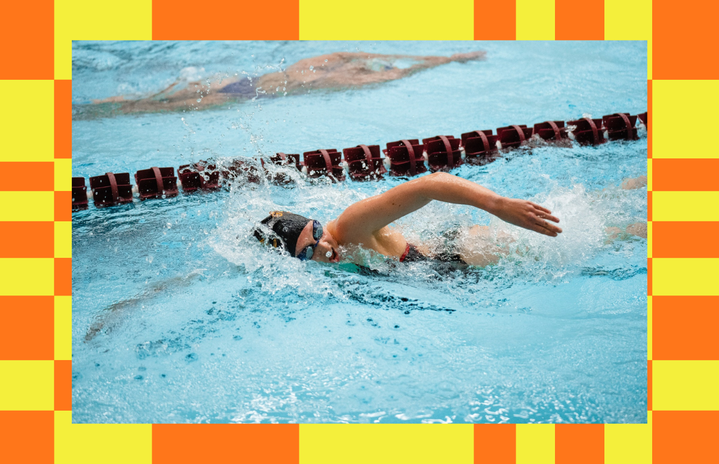Many American colleges and universities tout their well-rounded approach to education. They not only encourage, but require, students to take a variety of different courses and pass them prior to graduation. Often among these many requirements is physical education (PE). Students are sometimes surprised to learn that what was once part of their elementary and high school curriculums is now a part of their college education, too.
A shrinking number of schools take this PE requirement a step further by requiring their students to pass a college swim test. These mandatory tests involve students completing some sort of swimming activity to demonstrate their competency in the water. Only a handful of schools still perform them, leading some students to begrudgingly post their experience on TikTok. While these swim tests are becoming less common, they persist at a few remaining institutions as relics of the past. Understanding the history of swim tests is important for students to learn as they consider the role their universities play in making education accessible for all.
What Are The Origins Of Swim Tests?
There’s no specific, clear origin of swim tests at colleges and universities in the U.S. However, there are competing theories.
In the early 20th century, there was a push to ensure that collegians (mostly male at the time) could swim. It’s possible that this could have coincided with the World Wars of that time as well, a time in which military preparedness and physical fitness were at the forefront. Another competing theory — one that seems to exist at several schools — is that a student had drowned and the wealthy family of the student donated money to the school under the condition that swim safety was taught.
Since the 20th century, the tests have become less common as more schools have eliminated them. In 1977, around 42% of colleges had some sort of swim requirement. That figure has declined ever since.
Today, the holdout schools include Bryn Mawr, Columbia, Cornell, Dartmouth, MIT, Swarthmore, and service academies such as West Point. Schools that have eliminated swim tests in recent years include UNC Chapel Hill in 2006, University of Chicago in 2012, and Notre Dame in 2014. Williams College most recently voted to eliminate their swim test this past spring.
As swim tests continue to fade from existence, the question remains: What do the schools that continue to require these tests claim as their objectives? It turns out that different schools approach the swim test in different ways.
Cornell, for example, claims that the objective of their test is to “ensure that the student is able to survive and make their way to safety in case they are in a drowning situation.” They previously had different requirements for women and men, but in 1975 the school standardized the test required that students “jump into deep water and swim 3 lengths (75 yds) continuously. 25 yds on the front, 25 yds on the back, and 25 yds choice.”
At Columbia, some graduating students have had the requirement waived due to the pandemic. However, students graduating after summer 2022 will be required to pass the test once again. The school says that the test was established “in order to ensure that every student has the opportunity to learn and practice this important life — and life-saving — skill.”
Still, at neither of the above schools does the swim test coincide with swim lessons. Instead, students who wish to learn to swim must take lessons separately, either on their own or through a school-offered PE class sometime before graduation. It is another challenge added to their already busy and demanding schedules.
Who Is Most Impacted By Swim Tests?
Many students might consider swim tests a mild, if bizarre, inconvenience before graduation, but that’s not the case for everyone. When it comes to swimming proficiency and access, it’s important to understand the real-world disparities that exist.
In an article for the Chronicle of Higher Education, history professor Jeff Wiltse points to “clear and obvious past discrimination” as the primary factor behind swimming disparities. He identifies two eras during the 20th century in which swimming pool construction boomed and primarily benefited white Americans. Black Americans were mostly banned from these spaces and therefore prevented from receiving equal access to swimming instruction. He also notes that swimming proficiency exists along economic class divisions, as well, with middle- and upper-class groups enjoying better access than working-class people.
The data that exists on drowning rates in the U.S. also confirms this. A 2021 report from the CDC showed that from 1999–2019, people aged 29 and under died from unintentional drowning at rates that varied by racial and ethnic background. For example, compared with non-Hispanic white people, the rate was two times higher among American Indian or Alaska Native people and one-and-a-half times higher among non-Hispanic Black people. The disparity in drowning death rates between non-Hispanic Black and white people has also increased from 2005 to 2019.
A lack of access to swimming instruction therefore puts the burden on students who — by no fault of their own — have not had the same opportunities to learn to swim as their peers. This can create a great deal of anxiety for these students, making them feel as though they are inadequate and that they must find time to add swimming lessons to their semester.
Swim tests ignore the historical contexts and current inequities surrounding students’ access to the pool. If water safety and confidence is the goal of schools that still implement these outdated requirements, there are far better ways to do so that are more inclusive and less intimidating.
What Are Some Alternatives & How Can You Bring Change To This Issue?
One way that colleges can better serve their students is to drop the required swim test and instead expand their offerings for beginner, intermediate, and advanced swimming lessons. By doing so, students can find enjoyable ways to stay active without the pressure of passing a test that they might not have had the chance to prepare for.
If you are a student at one of the schools that still requires swim tests and you feel that these tests are unfair, here are some actions you can take:
- Attend student government meetings to raise the issue or get involved with the organization to make it a priority.
- Write an op-ed for your school’s student newspapers, publications, or Her Campus chapter.
- Reach out to the student affairs dean and request time to speak with them about this issue.
- Get other students involved who would like to see the swim test dropped or have better alternatives provided. There is power in numbers and school administrators won’t be able to ignore the voices of a group of passionate students.
No matter if your school has already dropped the swim test or still has it in place, understanding the different requirements to graduate will help you to identify the biases that exist within your institution — both academically and beyond. It might spur you to consider the other ways in which schools have antiquated systems in place, such as why PE requirements still exist and whether or not students with disabilities are able to fully participate in the same ways.
It’s important to keep yourself aware of what is being asked of you and other students as you navigate your college years. Continuing to learn about and push back against the things that are unnecessary and unfair is a meaningful way to stay engaged.


